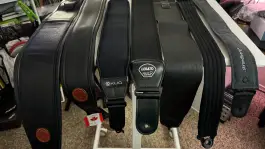A while back, I got a wild urge to make a YouTube video about, well, making YouTube videos. Over on my personal site, digitalnoise|studios, I wanted to put something together addressing various issues with production I often see on YouTube videos. Taking my experience with photography and audio, I wanted to create a YouTube video tutorial with tips and tricks for making better videos. And more than that, I wanted to show each individual element that can be added into a production, starting from one camera, no lights, no mics, and no manual techniques. In the video, I wanted to literally build a better YouTube video, piece by piece, and show a realistic increase in production that comes with each part of the whole.
That, and I just wanted to play around and make something new.
Contents
Audio for YouTube videos
The main issue I really wanted to cover is regarding the audio. As I mention in the video, audio is definitely the most important part of any video, and can’t be overlooked as far as YouTube video tips go. It’s all too often that people post videos with lots of hiss and noise, drowning out the actual vocal. The reason for this is usually because of the use of the onboard mic that’s built into the camera. These are usually very noisy, and also aren’t very directional. As a result, they pick up noise from all over the room, all of the reflections, mic noise, and external sounds all get compounded into a distracting audio track.
Automatic Gain Control vs manual gain settings
The other main issue with bad audio (and this is even an issue when using a lavalier mic or other external mic) is the lack of manual audio gain control. Basically, most cameras utilize an automatic gain control, or AGC, to manage the audio recording level. If you’re not sure what gain is, basically it’s like volume. It’s the input sensitivity of the incoming signal into the camera, whether it’s from an onboard mic or an external mic plugged in. Gain is the level of the incoming signal, whereas volume is the level of the audio being played back.
An AGC manages the gain based on what the the system detects coming into the mic. If sounds are loud, the AGC turns down the gain to avoid clipping, distortion, and obscenely loud volumes on playback. When sounds get quiet, the AGC jacks up the gain so that you don’t have to increase the volume on your computer, phone, or TV. This is helpful when you’re in a run-and-gun situation, and can’t necessarily control the gain level while filming, or can’t really predict any changes in loudness of the source being recorded.
Where the actual problem involving automatic gain control comes in is where you’re recording something with a large gap between the quiet and the loud. Or more accurately, a relatively quiet-ish room, and a person speaking into a camera. The AGC doesn’t know the actual difference between someone talking and the sound of an air conditioner in the room. It only knows the difference in loudness perceived by the mic. As a result of this, when the person is talking, the AGC sets the gain lower according to the incoming loudness. The subject stops talking, and then the AGC looks for the newly changed loudness–in this case, it’s a “silent” room, which is really not silent, but has more quiet sounds, such as an air conditioner, fans, outside noises, you get the idea.
So with these two drastically different levels of audio, the AGC is bouncing the gain down and up. And when the gain gets turned up in an attempt to match the level of the “silence” to the talking level, you get a very loud hiss. The person then starts talking again, and as you hear the speaking begin, you hear the hiss slowly lower in level, while the talking starts much louder, then gets lowered to a normal level. They stop talking again, and the hissing slowly ramps back up. This audio effect is referred to as “pumping”, in the audio production fields. In the video, I referenced an example using an EDM-ish track, where the majority of the music track dips in volume and breathes back to normal upon each hit of the kick/bass. As a more direct example involving YouTube videos, the very cool Whiteboard Wednesday videos from my budgeting app of choice, YNAB, are a great example of this, and how annoying/distracting it can be.
Especially in this example, the gain should be set manually based on the signal of Jesse’s spoken level. And using a lavalier mic here even contributes to the issue more due to the difference of Jesse’s voice being closer to the mic than the room sounds. And that’s not even getting into tonal differences, such as proximity effect).
The main point here is that the AGC should not be engaged in most situations like this, and this should be set manually. Manually controlled gain levels will help get better audio, even when using the onboard mic, but especially when using a lav mic.
Compression: Proper gain/level management for audio
So if you can’t necessarily use the AGC to keep levels the same, how do you manage the levels and make sure things are consistent? You want to maintain a solid level without much change in dynamics of the vocal, reducing volume peaks and boosting quieter spoken parts. But how?
Compression is the trick here. Compression is using either hardware or software to reduce the level of a signal or track, based on how far over a predetermined threshold the signal goes. This is a severely simplistic explanation of compression, but it’s the short short short SHORT version for the sake of brevity. One of my favorite mixing/audio production channels, The Pro Audio Files, has an excellent video introducing compression, how it works, and why you would use it, and is one of my go-to references when explaining what it is.
Basically, your post-production workflow for audio should involve compression, EQ, and noise reduction in some combination (and these concepts may find its way into another post/video of YouTube video tips). But honestly, compression alone could get the job done in a pure functional aspect of making playback for listeners/viewers much more pleasant.
Microphones and the rest of the production
In my video, I run through some audio samples using the onboard mic, a Rode Videomic Pro, and a Blue Bluebird, along with some other variables. I wanted to show the different levels of production by building up the video from scratch–AGC onboard mic audio–through disabling AGC, working up through mic options, and then adding external lighting, framing, and other production tips to help with video creation.
YouTube video tips – Conclusion
Each of the elements touched upon in the video could easily demand their own 20 minute videos independently, but I wanted to show the actual progression of adding each element into the production. Being able to walk a viewer through some real-world differences in gear, settings, and other steps in production is, I believe, a very useful demonstration and a helpful resource in deciding what you need and want in order to improve their own production. I just hope that it came across and is helpful to other new and aspiring YouTube creators.



![How to make money on YouTube [2022]](https://www.creatorbeat.com/wp-content/uploads/2020/09/Creatorbeat-How-to-make-money-on-YouTube-blog-265x149.jpg)
![How to create a YouTube channel [2022]](https://www.creatorbeat.com/wp-content/uploads/2020/09/Creatorbeat-How-to-create-a-youtube-channel-blog-265x149.jpg)
![How to start a vlog: The ultimate guide [2022]](https://www.creatorbeat.com/wp-content/uploads/2018/09/How-to-start-a-vlog-Blog-Retina-265x156.png)




0 thoughts on “YouTube video tips – building a better YouTube video”